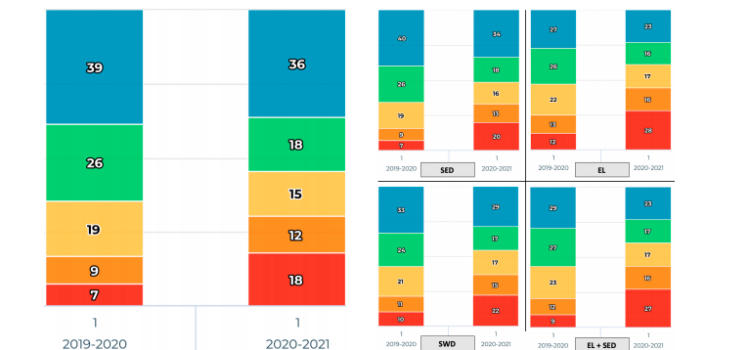
The Kern County Superintendent of Schools released data last week showing grades among local students in Kern’s three largest school districts have significantly dropped since shutting down schools nearly a year ago.
Across the Kern High School District, Bakersfield City School District, and Panama Buena-Vista Union School District — representing 45 percent of K-12 students in Kern County — the percentage of students in grades 6-12 who received Ds or Fs during the Fall 2020 semester increased by 14 percent compared to Fall 2019, according to KCSOS.
“We saw an increase of 14% In D’s and F’s as compared to last year with the majority of those coming from students in that middle range, B and C range, dropping down into the D and F range”, said Greg West, director of Kern Integrated Data System (KIDS).
The students most affected are those that are considered socio-economically disadvantaged, English Language Learners, students with disabilities and students who are both ELL and have disabilities.
KHSD data shows a 14 percent increase in students receiving Ds and Fs during Fall 2020, while BCSD students in grades 6-8 who received Ds or Fs during Fall 2020 increased by 17 percent. Lastly, Panama Buena-Vista Union School District data shows students in grades 6-8 receiving Ds or Fs increased by 13 percent.
Data for all districts shows the number of students receiving As and Bs has also dropped.
This local data, coupled with ongoing national research, illustrates that the unprecedented number of low grades across the nation can be attributed to shortcomings associated with distance learning, KCSOS said in a news release.
These challenges schools and students are facing are largely contributed to factors outside a student’s or teacher’s control. Examples include teachers and students adapting to a new learning modality, technology challenges, sporadic attendance, disengagement, limited adult support at home, and teachers finding it difficult to establish safe, trusting virtual classroom environments.
With this new data, many are calling on schools to implement some type of intervention to help these groups of students.
“We have intervention programs at the individual school sites, which include specific targeted tutoring and support programs,” said Brenda Lewis, associate superintendent of instruction at the Kern High School District.
At the elementary level, Bakersfield City School District is in the processing of developing a “robust” summer learning program, “hopefully in person, so that we can bring our kids back and offer them an additional series of weeks of learning to work through the struggles,” said Doc Ervin, BCSD’s superintendent.
At the state level, Governor Gavin Newsom has allocated $4.6 billion in state funding for extended learning opportunities. Additionally, more federal relief funds are likely to come. This will allow schools to implement learning loss mitigation strategies such as: acceleration academies (extended school days, weekend school, more robust summer school options, etc.); intensive tutoring opportunities; and informal and diagnostic assessments to determine learning loss.
KCSOS said school officials also acknowledge the need to provide some leeway to help students cope in this unprecedented school year. Such strategies include: providing more opportunity for extra credit assignments; extending assignment deadline; allowing exams to be retaken for a better grade; easing overall grading policies.
“I applaud our students and parents for continuing to focus on education and their resilience throughout this pandemic,” said Kern County Superintendent of Schools, Dr. Mary Barlow. “The data is not surprising. It’s a result of our unfortunate current reality and one that educators across the county have been working so hard to mitigate.”